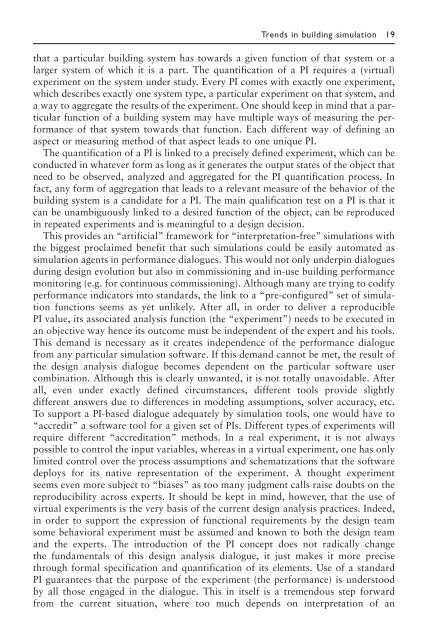Advanced Building Simulation
Advanced Building Simulation
Advanced Building Simulation
Create successful ePaper yourself
Turn your PDF publications into a flip-book with our unique Google optimized e-Paper software.
Trends in building simulation 19<br />
that a particular building system has towards a given function of that system or a<br />
larger system of which it is a part. The quantification of a PI requires a (virtual)<br />
experiment on the system under study. Every PI comes with exactly one experiment,<br />
which describes exactly one system type, a particular experiment on that system, and<br />
a way to aggregate the results of the experiment. One should keep in mind that a particular<br />
function of a building system may have multiple ways of measuring the performance<br />
of that system towards that function. Each different way of defining an<br />
aspect or measuring method of that aspect leads to one unique PI.<br />
The quantification of a PI is linked to a precisely defined experiment, which can be<br />
conducted in whatever form as long as it generates the output states of the object that<br />
need to be observed, analyzed and aggregated for the PI quantification process. In<br />
fact, any form of aggregation that leads to a relevant measure of the behavior of the<br />
building system is a candidate for a PI. The main qualification test on a PI is that it<br />
can be unambiguously linked to a desired function of the object, can be reproduced<br />
in repeated experiments and is meaningful to a design decision.<br />
This provides an “artificial” framework for “interpretation-free” simulations with<br />
the biggest proclaimed benefit that such simulations could be easily automated as<br />
simulation agents in performance dialogues. This would not only underpin dialogues<br />
during design evolution but also in commissioning and in-use building performance<br />
monitoring (e.g. for continuous commissioning). Although many are trying to codify<br />
performance indicators into standards, the link to a “pre-configured” set of simulation<br />
functions seems as yet unlikely. After all, in order to deliver a reproducible<br />
PI value, its associated analysis function (the “experiment”) needs to be executed in<br />
an objective way hence its outcome must be independent of the expert and his tools.<br />
This demand is necessary as it creates independence of the performance dialogue<br />
from any particular simulation software. If this demand cannot be met, the result of<br />
the design analysis dialogue becomes dependent on the particular software user<br />
combination. Although this is clearly unwanted, it is not totally unavoidable. After<br />
all, even under exactly defined circumstances, different tools provide slightly<br />
different answers due to differences in modeling assumptions, solver accuracy, etc.<br />
To support a PI-based dialogue adequately by simulation tools, one would have to<br />
“accredit” a software tool for a given set of PIs. Different types of experiments will<br />
require different “accreditation” methods. In a real experiment, it is not always<br />
possible to control the input variables, whereas in a virtual experiment, one has only<br />
limited control over the process assumptions and schematizations that the software<br />
deploys for its native representation of the experiment. A thought experiment<br />
seems even more subject to “biases” as too many judgment calls raise doubts on the<br />
reproducibility across experts. It should be kept in mind, however, that the use of<br />
virtual experiments is the very basis of the current design analysis practices. Indeed,<br />
in order to support the expression of functional requirements by the design team<br />
some behavioral experiment must be assumed and known to both the design team<br />
and the experts. The introduction of the PI concept does not radically change<br />
the fundamentals of this design analysis dialogue, it just makes it more precise<br />
through formal specification and quantification of its elements. Use of a standard<br />
PI guarantees that the purpose of the experiment (the performance) is understood<br />
by all those engaged in the dialogue. This in itself is a tremendous step forward<br />
from the current situation, where too much depends on interpretation of an

















